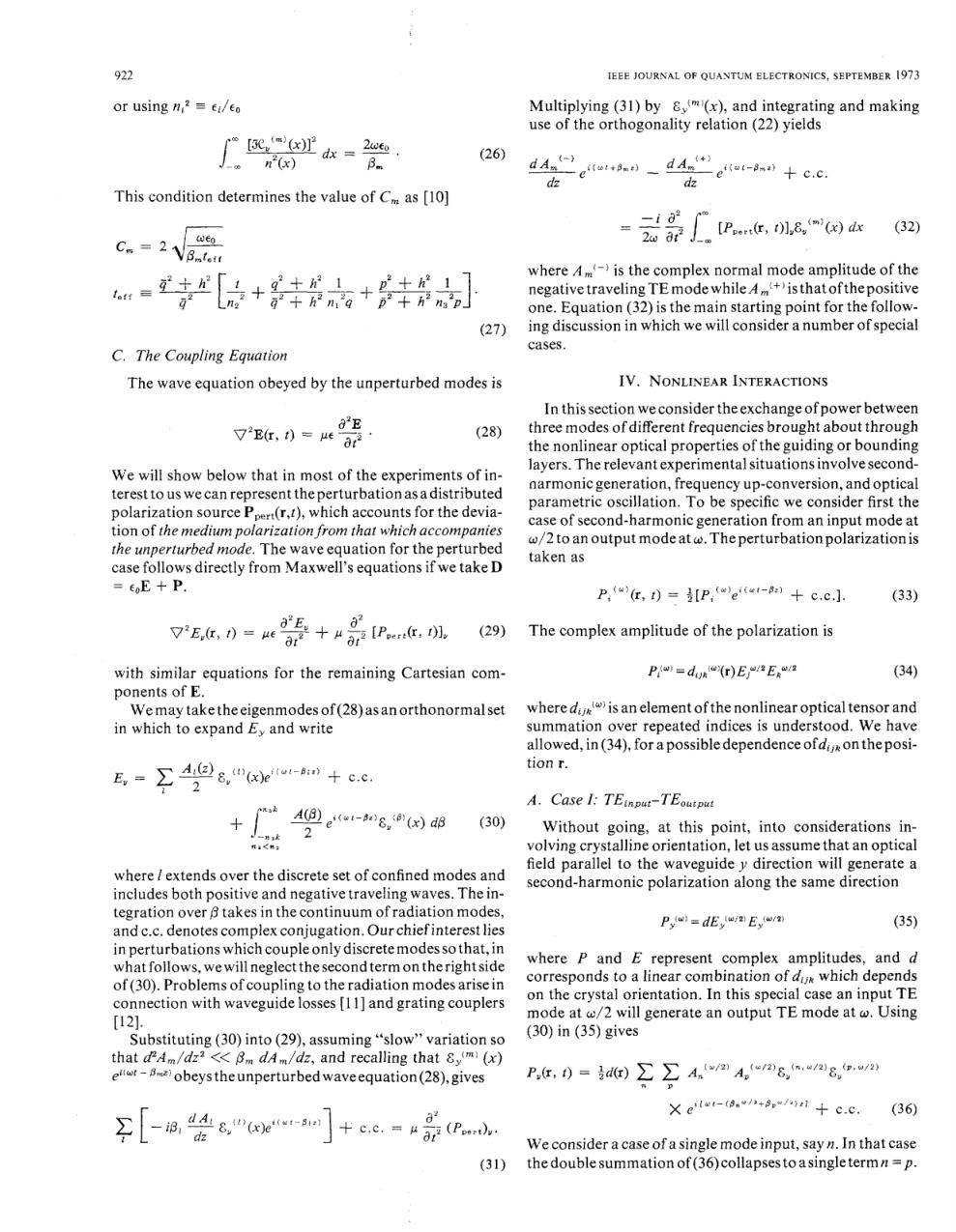正在加载图片...

922 IEEE JOURNAL OF QUANTUM ELECTRONICS,SEPTEMBER 1973 or using n2=/ Multiplying (31)by 8y(m(x),and integrating and making use of the orthogonality relation(22)yields dx (26) n2(x) B. dA《 ewt+dA -ewt-+c.c. dz dz This condition determines the value of Cm as [10] 部Re,k,w = (32) p2十 where Am is the complex normal mode amplitude of the negative traveling TEmode while Am+isthat ofthe positive 02 方2+9十h1 g+h2nq one.Equation(32)is the main starting point for the follow- (27) ing discussion in which we will consider a number of special cases. C.The Coupling Equation The wave equation obeyed by the unperturbed modes is IV.NONLINEAR INTERACTIONS In this section we consider the exchange of power between 7gk,)=μea (28) three modes of different frequencies brought about through the nonlinear optical properties of the guiding or bounding We will show below that in most of the experiments of in- layers.The relevant experimental situations involve second- narmonic generation,frequency up-conversion,and optical terest to us we can represent the perturbation as a distributed parametric oscillation.To be specific we consider first the polarization source Ppert(r,t),which accounts for the devia- tion of the medium polarization from that which accompanies case of second-harmonic generation from an input mode at w/2 to an output mode at w.The perturbation polarization is the unperturbed mode.The wave equation for the perturbed taken as case follows directly from Maxwell's equations if we take D =6oE+P. P,m红,)=P,weu-)十c.c.l. (33) 72E(c,t)=4e [P) (29) The complex amplitude of the polarization is with similar equations for the remaining Cartesian com- P)=dun(r)EE (34) ponents of E. We may taketheeigenmodes of(28)asan orthonormal set whered is an element of the nonlinear optical tensor and in which to expand Ey and write summation over repeated indices is understood.We have allowed,in(34),for a possible dependence ofdi on the posi- E,=∑42&,“o-n十cc tion r. 2 A.Case I:TEinput-TEoutput A(@et-8,(x)d的 (30) Without going,at this point,into considerations in- 一k 11<有: volving crystalline orientation,let us assume that an optical field parallel to the waveguide y direction will generate a where extends over the discrete set of confined modes and second-harmonic polarization along the same direction includes both positive and negative traveling waves.The in- tegration over B takes in the continuum of radiation modes, and c.c.denotes complex conjugation.Our chiefinterest lies P)=dE E) (35) in perturbations which couple only discrete modes so that,in what follows,we will neglect the second term on theright side where P and E represent complex amplitudes,and d of(30).Problems of coupling to the radiation modes arise in corresponds to a linear combination of dus which depends connection with waveguide losses [11]and grating couplers on the crystal orientation.In this special case an input TE [121. mode at w/2 will generate an output TE mode at w.Using Substituting(30)into(29),assuming"slow"variation so (30)in (35)gives that dAm/dz2<<Bm dAm/dz,and recalling that 8,(m)(x) el-obeys the unperturbed waveequation(28),gives P,,0=d)∑∑Ano/2Ae/8,e8,m Xelu-(8c.c. (36) We consider a case of a single mode input,say n.In that case (31) the double summation of(36)collapsesto asingle termn=p.922 IEEE JOURNAL OF QUANTUM ELECTRONICS, SEPTEMBER 1973 Multiplying (31) by &y(m)(x), and integrating and making use of the orthogonality relation (22) yields 2W€o dx = - Pn This condition determines the value of C, as [lo] I (27) C. The Coupling Equation The wave equation obeyed by the unperturbed modes is a2E at V2E(r, t) = pe -3 . We will show below that in most of the experiments of interest to us we can represent the perturbation as a distributed polarization source Ppert(r,t), which accounts for the deviation of the medium polarization from that which accompanies the unperturbed mode. The wave equation for the perturbed case follows directly from Maxwell's equations if we take D = coE + P. with similar equations for the remaining Cartesian components of E. We may take theeigenmodes of (28) as an orthonormal set in which to expand E, and write where 1 extends over the discrete set of confined modes and includes both positive and negative traveling waves. The integration over /3 takes in the continuum of radiation modes, and C.C. denotes complex conjugation. Our chiefinterest lies in perturbations which couple only discrete modes so that, in what follows, we will neglect the second term on the right side of (30). Problems of coupling to the radiation modes arise in connection with waveguide losses [ 1 11 and grating couplers Substituting (30) into (29), assuming "slow" variation so that d2Am/dz2 << Dm dAm/dz, and recalling that &ycml (x) P21. ei(wt - Omz) obeys the unperturbed wave equation (28), gives where A m(-j is the complex normal mode amplitude of the negative traveling TE mode while A m(+) is that of the positive one. Equation (32) is the main starting point for the following discussion in which we will consider a number of special cases. IV. NONLINEAR INTERACTIONS In thisection we consider the exchange of power between three modes of different frequencies brought about through the nonlinear optical properties of the guiding or bounding layers. The relevant experimental situations involve secondnarmonic generation, frequency up-conversion, and optical parametric oscillation. To be specific we consider first the case of second-harmonic generation from an input mode at w/2 to an output mode at w. The perturbation polarization is taken as The complex amplitude of the polarization is where dijk("') is an element of the nonlinear optical tensor and summation over repeated indices is understood. We have allowed, in (34), for apossible dependence ofdij,ontheposition r. A. Case I: TEinpUt-TEoutpUt Without going, at this point, into considerations involving crystalline orientation, let us assume that an optical field parallel to the waveguide y direction will generate a second-harmonic polarization along the same direction where P and E represent complex amplitudes, and d corresponds to a linear combination of dijk which depends on the crystal orientation. In this special case an input TE mode at w/2 will generate an output TE mode at w. Using (30) in (35) gives We consider a case of a single mode input, say n. In that case the double summationf (36) collapses to asingle term n = p